It’s not often that a Glyndebourne production offers its audience an interactive experience. But, that’s what seemed to be happening towards the close of the final Act of the second performance of Ethel Smyth’s The Wreckers, the opening production of Glyndebourne’s 2022 Festival. As the kangaroo court neared its climactic judgement, and the bigoted mob of Cornish wreckers brayed and bellowed at those accused of betraying the community code and sabotaging their murderous exploits, the turbulence – human cries, orchestral wind and wave, flickering torchlights amid the blackness of Piper’s Hole – reached their peak. When a siren was added to the mix and the houselights began to stutter, it seemed as if we were being drawn into the mob violence, involved and implicated.
It took a few moments for the realisation to dawn that the Glyndebourne fire alarm had joined in the operatic clamour. House personnel appeared on stage to issue calm explanations to the audience and instructions to the cast. One felt desperately sorry for the singers and the LPO musicians who had been singing and playing their hearts out, creating an unstoppable momentum towards the raw, searing climax of Smyth’s opera. It took a good ten minutes or so before the performance was able to resume, and that almost instantly we were transported back within the religious fanaticism and fury attests to how dramatically gripping this whole performance had been. Indeed, it was largely because director Melly Still and designer Ana Inés Jabares-Pita had so convincingly conjured the dark menace and moral murkiness of the villagers and their environs that the external intrusion had been so readily accepted.
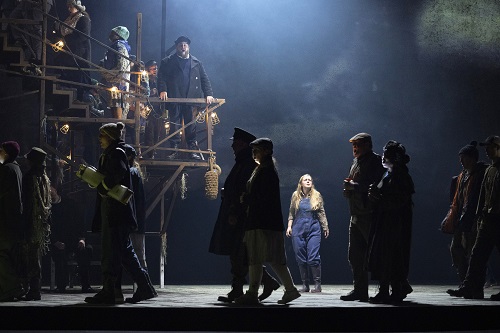
The Wreckers was inspired by a visit that Smyth made in 1886 to the Piper’s Hole on Tresco in the Isles of Scilly – a fresh-water cave full of blind fish and accessed by a chained boat like Charon’s ferry. She asked her philosopher-friend and erstwhile lover, Henry Bennet Brewster, to write a libretto and the result was a tale of Cornish bigotry in the eighteenth century. The eponymous community live by luring boats to distress on the coastal rocks, murdering the seafarers and plundering their cargo, convinced by Pasko, a fanatical Sabbatarian, that the lighthouse keeper, Laurent, is justified in turning off his warning beacon, and that it is Providence that they live on the spoils of others’ deaths.
Jabares-Pita’s set eschews stage clutter. In Act 1, some steps to a raised door indicate the house where Pasko keeps his young bride Thurza in a suffocating, oppressive marital embrace. In Act 2, a few nets and a cliff-top beacon provide a locale for Thurza and her lover Marc to challenge the village hypocrisy through their passion and their fire-lighting. A scaffold-stairway leads down into the Hadean blackness of the Hole in Act 3. Throughout the drama, the use of a revolve creates the effect of a net being spun around all, like a poisonous spider’s web, the tension enhanced by Malcolm Rippeth’s suggestive lighting.
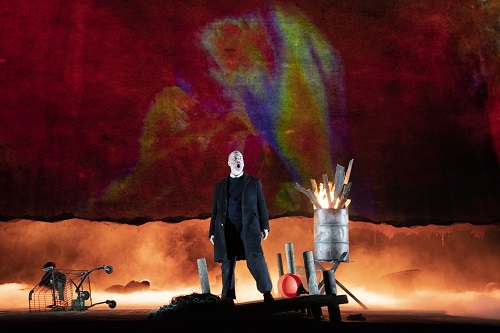
Emphasis is thrown on the back wall, onto which video designer Akhila Krishnan projects images, fragments and intimations. The monochrome faces of community emerge from the darkness, then recede. Streaks of murky blue, brown and grey evoke a cruel sky and sea: the whirl of crashing waves, wind-buffeted stormy clouds, an underwater fogginess – a metaphor for the wreckers’ moral blindness. Red tints of light turn the watery flickers to fervent flames, evoking the victims’ shed blood and the sin and guilt of hellfire.
It’s an apt visual canvas to accompany Smyth’s score which is itself cinematic in idiom. Smyth was undoubtedly a proverbial force of nature – radical, crusading and passionate, in music, politics and in her relationships, both professional and private. At the age of 19 she persuaded her father, an army major general, to let her go to Leipzig, unaccompanied, to study music. Her suffragettism saw her endure a spell of imprisonment. Her passions included golf, hunting and mountain climbing. She was tireless and sometimes tiresome. Count Seebach, the intendant of Dresden Opera is reported to have said that he ever saw her on the street, he would jump in a cab, head to the station and catch the first train out of town.
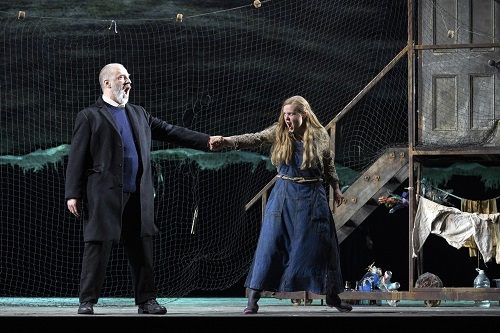
But, her music isn’t trail-blazing. It lacks a distinctive voice and is instead a mishmash of eclectic echoes and borrowings – heavy Wagnerian low strings and brass, the spirit if not the style of verismo, impressionistic textures as in the Prelude to Act 2, which confirms her strong and imaginative feeling for orchestral atmosphere and musical mood. The composer of whom I was most strongly reminded in this regard was Korngold. There are sudden shifts between some of the multifarious modes, and it’s difficult to discern a cohesive design – harmonic or structural. The decision at Glyndebourne to reinstate some 20-30 minutes of music which was cut from the original full score (drawn from a manuscript in a copyist’s hand, now in the British Library) – revisions probably sanctioned by Smyth for the 1909 Covent Garden production – only exacerbated the problem.
Also, why was the French version of the libretto chosen? It was the Franco-American Brewster who originally suggested a text in French verse (the opera was titled Les naufrageurs), according to Smyth because it was ‘the language he preferred when poetically disposed’, but probably also because it was rumoured that André Messager of the Opera Comique, whom Smyth knew, would be the new artistic director of Covent Garden, and so an opera in French might have a good chance of imminent performance. But, in the end The Wreckers premiered in Leipzig and then travelled to Prague, in 1906, and was presented in German (as Strandrecht), and it was in this form that it was first performed in London in 1909, conducted by Sir Thomas Beecham. Smyth later made her own English translation. Here, the French text was practically indecipherable – though given the demands made upon the singers by Smyth’s relentless high, loud vocal lines, that’s perhaps understandable. The final directorial intervention was the inclusion of four female dancers – their Edwardian dress suggesting, perhaps, that they were tropes for Smyth herself – whose writhing, rolling and arm-waving, didn’t seem to me to add anything particularly meaningful.
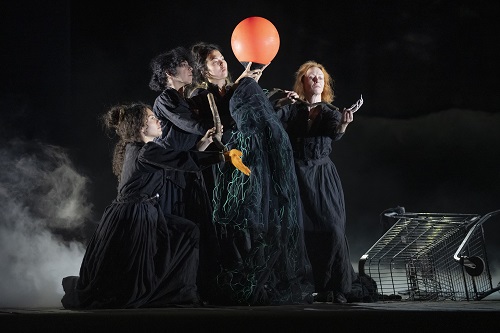
What Smyth does do well is harness huge Verdian choruses to theatrical and emotive effect, and the Glyndebourne Chorus were in tremendous voice in the framing Acts. Still manoeuvred the mass forces effectively, making the members of the Chorus distinct individuals within the fearsome unity of the crowd, though in the ensemble scenes the principals were sometimes left to their own devices.
The melodic writing is rather ungrateful, sometimes comprising intoned dialogue or recitative on a repeated note. Smyth pushes the singers high and hard, though there are moments of lyricism, such as the duet for Mark and Thurza in Act 2, and Pasko’s subsequent distress and disillusionment when he discovers his wife’s scarf beside the burning beacon. The LPO under Robin Ticciati were on superb form and absolutely committed, but the unalleviated vigour and power of Smyth’s score at times made it even more difficult for the singers.
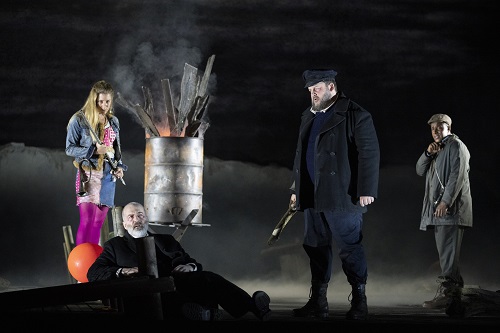
As Mark, tenor Rodrigo Porras Garulo sang with ardent lyricism, especially in the final Act when he and Karis Tucker’s Thurza soared above the orchestral tsumani as they waited for the rising waters surging into the cave to claim them, Aida-style. Tucker had displayed sympathetic colours and tone but at the close her mezzo was further enriched by a burning fierceness. As Avis, the lighthouse-keeper’s daughter who is in love with Mark, soprano Lauren Fagan embraced the stridency – vocal and dramatic – of the role with impressive staunchness. Her vignette, ‘The Rat’, was a terrifyingly brutal explosion of hatred and humiliation.
Bass-baritone Philip Horst was an unforgiving power-hungry pastor, his thunder fuelled by pedantry and self-righteousness, and if bass-baritone James Rutherford’s lighthouse keeper, Laurent, initially showed signs of wanting to play a fair hand, during Act 3 he whipped up the villagers’ lust for vengeance with vicious force. As Tallan, the hostel keeper, tenor Jeffrey Lloyd Roberts offered a welcome alternative, if brief, to the prevailing religious fervour. Mezzo-soprano Marta Fontanals-Simmons was sweet of tone as his son, Jacquet, whose adolescent feelings for Avis are exploited by the latter to bring down the lover who rejects her. The small role of Harvey was engaging sung by bass-baritone Donovan Singletary.
The Wreckers presents pregnant dramatic themes, but Brewster’s libretto doesn’t offer persuasive characterisation or motivation. And, while the dramatic temperature is unwavering high, the action is not ‘tragic’. Not a single character experiences internal conflict. And, ‘right’ and ‘wrong’ are never in doubt. Pasko propounds his defence of wrecking as God-ordained with the unbending self-belief of a religious martyr; even his request that the drumhead court spare Thurza is motivated by a twisted desire to make her live under the burden of sin and remorse. That she and Mark refuse to conform and adhere to the local ‘moral code’ doesn’t make them tragic figures, just victims. The opera is a pressure cooker and it sometimes feels that one more fever-pitched climax will push the melodrama beyond its bounds and into the realm of parody. That this Glyndebourne production proved so compelling in the theatre, despite the unwelcome interruption, says much.
Claire Seymour
Ethel Smyth – The Wreckers
Tallan – Jeffrey Lloyd-Roberts, Jacquet – Marta Fontanals-Simmons, Harvey – Donovan Singletary, Pasko – Philip Horst, Avis – Lauren Fagan, Laurent – James Rutherford, Thurza – Karis Tucker, Marc – Rodrigo Porras Garulo, Dancers – Rosie Bell, Lucy Burns, Tash Chu, Sirena Tocco; Director – Melly Still, Conductor – Robin Ticciati, Designer – Ana Inés Jabares-Pita, Choreographer – Mike Ashcroft, Lighting Designer – Malcolm Rippeth, Video Designer – Akhila Krishnan, London Philharmonic Orchestra, The Glyndebourne Chorus (Chorus Director, Aidan Oliver)
Glyndebourne Festival Opera; Wednesday 25th May 2022.
ABOVE: The Wreckers, Act 1 (c) Richard Hubert Smith